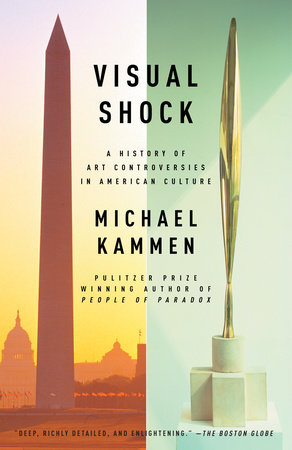Book Review: A History of Art Made to Shock
Edgar Degas once said that painting should be akin to committing a crime. And many Americans saw creation of some of the most important works of American art as just that—roguish, cunning and wicked—in short, criminal.
Visual Shock: A History of Art Controversies in American Culture by Michael Kammen. Penguin Random House, 480 pages, $18.
By Adrienne LaFrance
 Edgar Degas once said that painting should be akin to committing a crime. And many Americans saw creation of some of the most important works of American art as just that—roguish, cunning and wicked—in short, criminal. In his thoroughly rewarding book Visual Shock: A History of Art Controversies in American Culture, Michael Kammen explores the complete span of controversies in American art. Readers will easily recall some of the most recent social squalls, like the uproar over “Sensation,” an exhibit that visited the Brooklyn Museum of Art and featured a depiction of the Virgin Mary crafted from elephant dung and surrounded by a collage of photos of female genitalia. Rudy Giuliani infamously deemed the exhibit too “horrible and disgusting” to be protected by first amendment rights.
Edgar Degas once said that painting should be akin to committing a crime. And many Americans saw creation of some of the most important works of American art as just that—roguish, cunning and wicked—in short, criminal. In his thoroughly rewarding book Visual Shock: A History of Art Controversies in American Culture, Michael Kammen explores the complete span of controversies in American art. Readers will easily recall some of the most recent social squalls, like the uproar over “Sensation,” an exhibit that visited the Brooklyn Museum of Art and featured a depiction of the Virgin Mary crafted from elephant dung and surrounded by a collage of photos of female genitalia. Rudy Giuliani infamously deemed the exhibit too “horrible and disgusting” to be protected by first amendment rights.
Kammen reminds us that as recently as the 1930s, Bostonians were horrified by the “disorder” of Picasso’s paintings, which sparked a nationwide campaign for “sanity in art.” The boom of controversy in the urban American art-scape of the 1960s is the focal point of “Visual Shock,” though Kammen also covers many of the scandals that took place in sleepy Midwestern towns that may be lesser known but led to heated social debates just the same.
Throughout the book, Kammen writes with clarity and passion, and successfully examines the way controversies in art reflect a visible progression of American social identity on a greater scale. Still, he falters at times. In his section on “nudity, decency, and morality,” delving more deeply into the social context of time periods discussed would enrich the material. Without specific differentiation, it grows tiresome to merely read a list of works featuring nudes that garnered public dismay. The section is slow at times but Kammen does manage to sum it up interestingly: “What bothered Americans above all in the indeterminate realm of decency and indecency was not nudity per se, or even passion and voluptuousness…but ‘conscious sexuality.’”
Kammen also offers a compelling- if neutral- working definition of modernism, describing it as art going beyond a statement or evocation of—and only of—human affairs. For the amount of seriousness that has met art controversies in America over the years, Kammen manages to keep his pace snappy and his tone often humorous, particularly when discussing the difficulty with which Americans accepted modernism. For example, Kammen tells readers that judging by the positioning of screw holes on the back of the frame of Matisse’s “Le Bateau,” it seems the piece may have been hung right side up only one time in 10 years on display.
One of the most fascinating examples he provides surrounds a legal precedent set after a controversy over Constantin Brancusi’s 1926 sculpture, “Bird in Space,” (which is featured on the book’s cover next to a photo of the Washington Monument). When artist and curator Edward Steichen purchased the shiny, oblong, upright piece of bronze in Paris, two conservative curators from the Metropolitan Museum alerted customs inspectors at the Port of New York. Kammen explains, “An official there ruled in turn that Bird could not be admitted duty free as a work of art. Rather he considered it merely a manufactured piece of metal and dutiable at 40 percent of its value—paradoxically, not its value in bronze but rather its value as a sculpture, even though the inspector ruled that it could not be sculpture because it did not look like a bird!”
When the case went to court, a judge ruled in favor of Steichen, explaining that although “Bird in Space” may be as inexplicable as the new school of art that favored abstract ideas over imitation of natural objects, it was still a piece of sculpture. All in all, the book is a success. Even the most well-versed American art buffs will delight in its comprehensiveness. Kammen is at his best when chipping away at some of the most essential questions modern art has to offer: What is art and why does is matter? To uncover these elusive answers, the author makes the inexorable link to another equally important, fluid, social question: How does our relationship with art show who we are as Americans? In retrospect, the most shocking aspects of American art aren’t found within the art itself but rather in the public’s consternation in response to it.
Tagged: Michael Kammen, Visual Shock: A History of Art Controversies in American Culture

This website had led me into controversies in art and different opinions about it, but it would help if it could lead me to more specific details or websites where I could look at more issues of art.